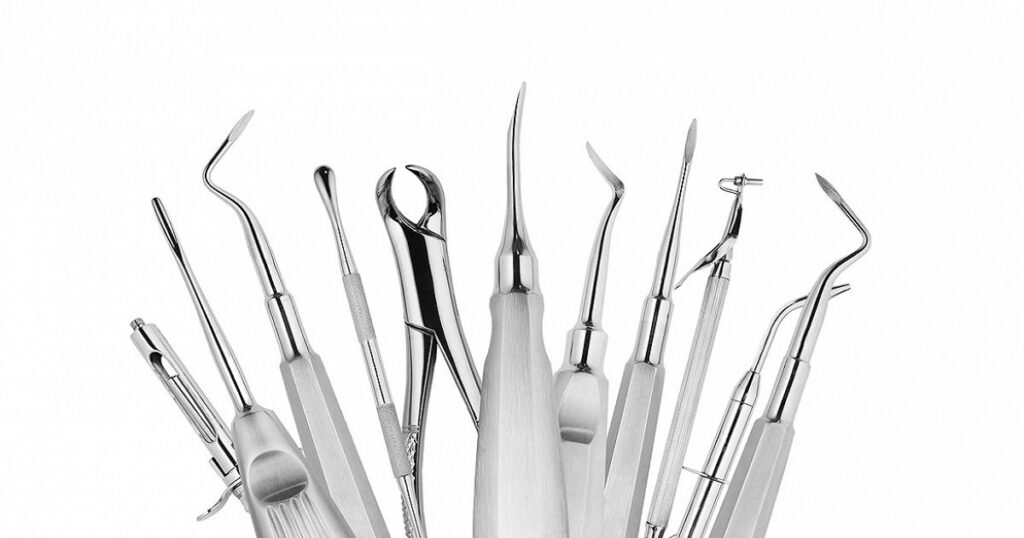In the ever-evolving field of dentistry, precision and expertise are paramount, and quality dental instruments play a crucial role in delivering effective patient care. The dental industry in the United States relies on a diverse range of dental instruments US specifically designed for accuracy, efficiency, and patient comfort.
From routine examinations to complex oral procedures, each instrument in a dental practitioner’s toolkit has a specialized purpose. Here, we introduce five essential professional Dental Instruments US and discuss their distinct functions. With insights into these tools, patients and aspiring dental professionals alike can better understand the precision required in oral healthcare.
1. Dental Mirror
The dental mirror is a simple yet essential tool in every dental professional’s kit. This instrument consists of a small, round mirror attached to a metal handle and serves multiple purposes. Its primary function is to provide indirect vision by reflecting images of areas in the mouth that are difficult to see, such as the back teeth, roof of the mouth, and gums. The mirror also aids in retracting lips, cheeks, and tongue, offering better visibility and access to specific parts of the mouth. This dual functionality makes it an indispensable tool during routine dental exams and various procedures. Additionally, the dental mirror assists in illuminating the oral cavity by reflecting light onto darker areas, helping dentists accurately inspect, diagnose, and treat dental issues. In the US, dental mirrors are standardized and available in various sizes. Ensuring optimal comfort and efficiency for both patients and dental practitioners.
2. Dental Probe
The dental probe, often referred to as an explorer, is a pointed instrument commonly found in dental clinics. Examining teeth and gums for cavities, rotting, and other anomalies is its main purpose. Dental probes come in different types, such as the straight probe and periodontal probe, each serving a specific diagnostic purpose. The straight probe is used to detect cavities, while the periodontal probe measures the depth of gum pockets around the teeth, helping to assess gum health and identify issues such as periodontitis.
3. Scaler
Scaling is a critical part of dental hygiene aimed at removing plaque and tartar build-up. Which can lead to gum disease if left untreated. Scalers pointed instruments with curved or hooked ends. Designed specifically to scrape off hardened deposits from the tooth surface and below the gum line. Scalers come in a variety of forms, including manual and ultrasonic models. Manual scalers require careful hand movement by the dentist, whereas ultrasonic scalers use high-frequency vibrations to break down plaque and tartar, making the process faster and less physically demanding for the practitioner.
4. Dental Drill
Among the most recognized dental instruments is the dental drill, a high-speed rotary tool used in procedures such as filling cavities, preparing teeth for crowns, and reshaping tooth structure. The dental drill’s primary function is to remove decayed parts of the tooth efficiently, leaving a clean surface for restorative work. It operates at speeds ranging from 100,000 to 400,000 revolutions per minute (RPM), making it one of the most powerful and precise tools in dentistry. In addition to treating decay, dental drills equipped with water jets that cool the area. Preventing heat build-up that could cause discomfort to the patient.
5. Dental Forceps
When performing tooth extraction treatments, dental forceps are necessary. These tools are specially designed pliers that grip and remove teeth from their sockets. Forceps come in various shapes and sizes, each tailored to accommodate different types of teeth, such as molars, premolars, and incisors. The curved design and strong grip of dental forceps enable a dentist to extract teeth efficiently while minimizing trauma to the surrounding tissues.
Conclusion
The field of dentistry in the US relies on a sophisticated array of tools, each serving a specific function to ensure patient care is precise, safe, and effective. Understanding the purpose and use of dental instruments like the dental mirror, probe, scaler, drill, and forceps offers insight into the complexities of oral healthcare. These instruments not only allow for comprehensive diagnoses and treatments but also contribute to preventive care that supports long-term dental health. For dental professionals, choosing high-quality instruments from reputable suppliers such as Dental Instruments US is essential for maintaining professional standards and achieving successful outcomes. With advancements in technology and design, these instruments continue to enhance dental practices across the United States, ensuring that patients receive the best possible care for their oral health needs.
FAQs
What are dental instruments used for?
Dental instruments are used for various purposes, including diagnosis, treatment, cleaning, and extraction. They enable dentists to perform precise and effective procedures, ensuring optimal oral health for patients.
Why is it important to have quality dental instruments?
They reduce the risk of complications, enhance patient comfort, and support the overall success of dental treatments.
Are dental mirrors used in every dental examination?
Yes, dental mirrors typically used in every examination. They provide indirect vision and help the dentist access hard-to-see areas in the mouth. Making it easier to inspect and diagnose issues.
What makes ultrasonic scalers different from manual scalers?
Ultrasonic scalers use high-frequency vibrations to remove plaque and tartar more efficiently than manual scalers. Reducing the time required for scaling procedures and enhancing patient comfort.
Do dental drills hurt?
Modern dental drills are designed to as painless as possible. They often come with water jets that keep the tooth cool, minimizing discomfort. Dentists also use anesthesia to numb the area before drilling.
Are forceps only used for tooth extraction?
While extraction is the primary use, dental forceps also used to grip. And move other small items during oral surgery, depending on the procedure.



